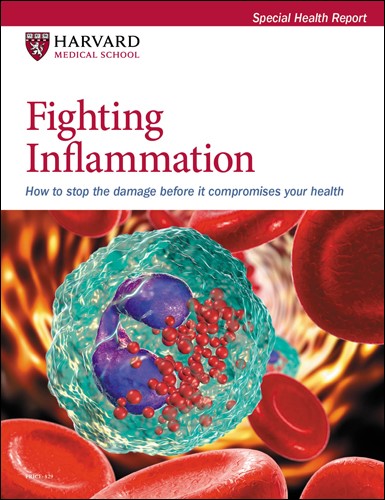An anti-inflammatory diet may be good for your joints
Changing your diet can't cure conditions like arthritis, but it may help prevent or manage them.
 Foods that reduce inflammation inside the body are all the rage these days — and for good reason. Eating these foods over time has been linked to a lower risk of numerous health conditions, including heart and blood vessel problems and chronic diseases such as diabetes.
Foods that reduce inflammation inside the body are all the rage these days — and for good reason. Eating these foods over time has been linked to a lower risk of numerous health conditions, including heart and blood vessel problems and chronic diseases such as diabetes.
But can a diet rich in anti-inflammatory foods also help your joints?
"Research seems to show a benefit when it comes to prevention," says Natalie McCormick, a research fellow in medicine at Harvard Medical School. "Studies, such as the Nurses' Health Study, have found that not only can an anti-inflammatory diet help to prevent arthritis, but it may also prevent conditions like heart disease and diabetes that people with arthritis are more likely to develop."
Eat a healthy diet over the years, and you may be less prone to conditions such as gout or other types of arthritis. The benefit is less clear if you've got joint problems already, says McCormick. But it may still help.
"Diet can be part of disease management," she says. "But it's not necessarily a cure-all for joint pain on its own."
Understanding inflammation
Inflammation inside the body occurs when your immune system leaps into action to heal an infection or injury by sending in an army of white blood cells. If you have a cut, the area around it may turn red or swell as this healing process occurs. But once the problem is under control, inflammation recedes, and your body returns to normal.
Chronic inflammation is not so helpful to your body. If you are under chronic stress, are obese, or have an autoimmune disorder, inflammation doesn't go away. It persists, damaging the body and potentially leading to problems such as arthritis, heart disease, or cancer.
Eating the right diet may help to switch off this inflammatory process, protecting your body from harm. There are still many unknowns about how the food you eat relates to the levels of inflammation in your body. But evidence of a potential benefit is growing.
"When researchers first started looking at diets that produced anti-inflammatory effects, they were interested in whether they could reduce heart disease and cancer. But over the years, other benefits have emerged," says McCormick. This includes the protection that these diets may afford the joints.
Some painful joint conditions are potentially triggered or exacerbated by inflammation in the body. For example, gout, which is caused by a buildup of a substance called uric acid, occurs when tiny crystals form in the joints. These crystals irritate the tissues in the joint and can trigger chronic inflammation. Even osteoarthritis, which was once thought of as just wear and tear on joints, is now known to be associated with chronic inflammation, albeit less than what is seen in other types of arthritis.
Choosing the right diet
There are two main dietary patterns that are thought to produce anti-inflammatory benefits, says McCormick. These are the Mediterranean diet and the DASH diet. The Alternative Healthy Eating Index, which measures diet quality, can also be used to work toward a similar healthy eating pattern that has been shown to improve health — lots of fruits and vegetables; healthy fats, such as olive oil; whole grains; and lean meats, fish, and legumes. These diets don't include many of the foods in a Western-style diet, such as highly processed and sugary foods and drinks and red and processed meats.
Researchers have noted a reduction in various measures of inflammation inside the body, such as a substance called C-reactive protein, in people who regularly opt for an anti-inflammatory dietary pattern. People who eat a Western-style diet have seen the opposite effect.
Over time, a healthy dietary pattern may reduce your risk of developing a painful joint condition. An anti-inflammatory eating pattern over the years may cut your risk of gout by as much as 60%, says McCormick. A steady diet of anti-inflammatory foods may also help to reduce joint pain for people living with osteoarthritis and potentially slow the progression of damage.
To get the most benefit you've got to eat a variety of anti-inflammatory foods, ideally over a number of years, she says.
While questions still need to be answered about the role of food in fighting inflammation, what is known is that the foods that appear to reduce inflammation also tend to be good for you for other reasons. So, there is really no drawback to adding more of these foods into your daily meal plan.
You don't necessarily have to pick one anti-inflammatory diet over another, says McCormick. Rather, you can mix and match elements to suit your personal lifestyle and tastes. Red meats and sugary beverages are associated with increased risk of gout, says McCormick. So, you should eliminate those if possible.
Choosing a healthy eating pattern may have broad health benefits protecting against a variety of conditions.
"You don't have to choose one type of food to prevent one condition and something else for another," she says.
Image: © pundapanda/Getty Images
About the Author

Kelly Bilodeau, Former Executive Editor, Harvard Women's Health Watch
Disclaimer:
As a service to our readers, Harvard Health Publishing provides access to our library of archived content. Please note the date of last review or update on all articles.
No content on this site, regardless of date, should ever be used as a substitute for direct medical advice from your doctor or other qualified clinician.
















